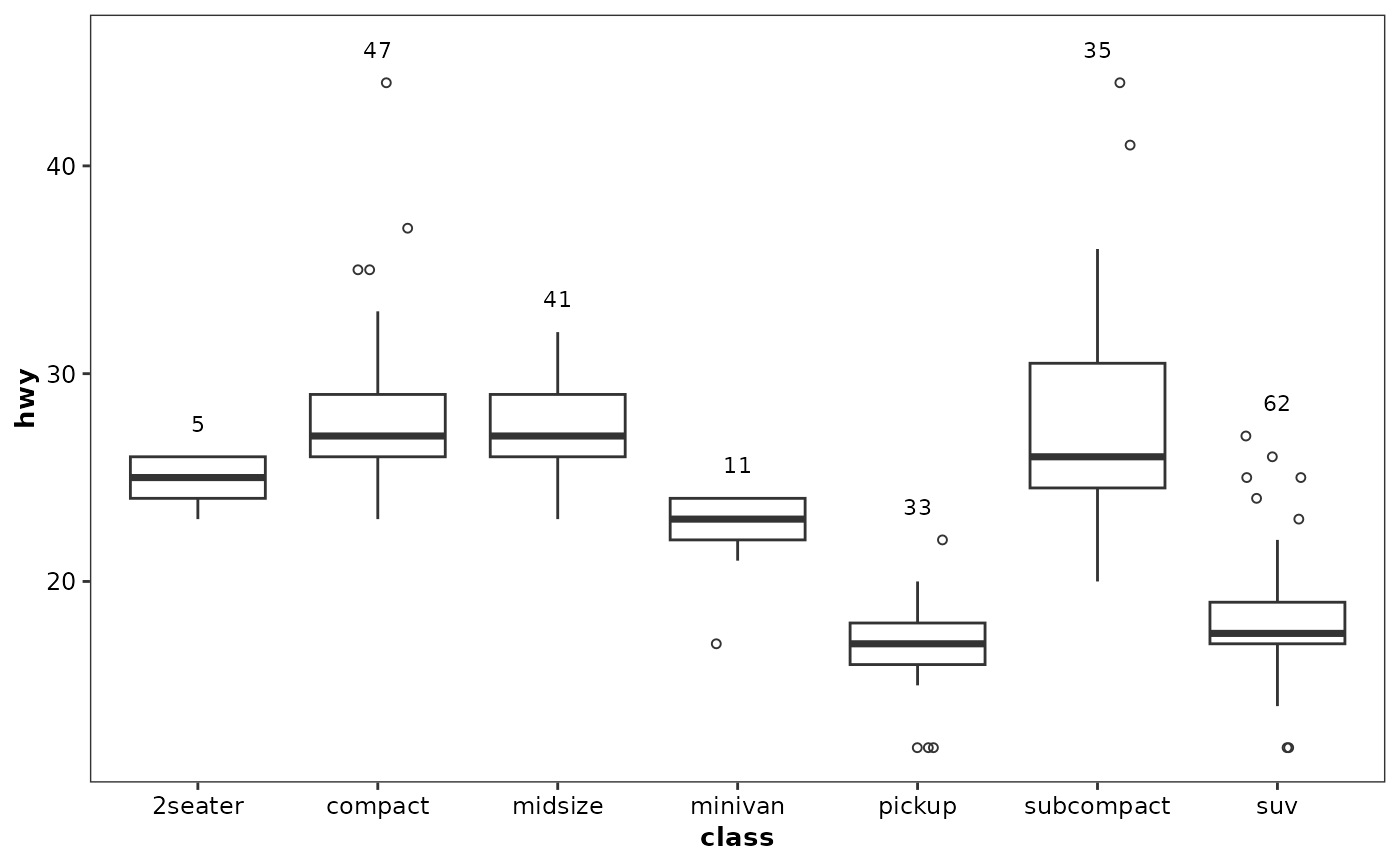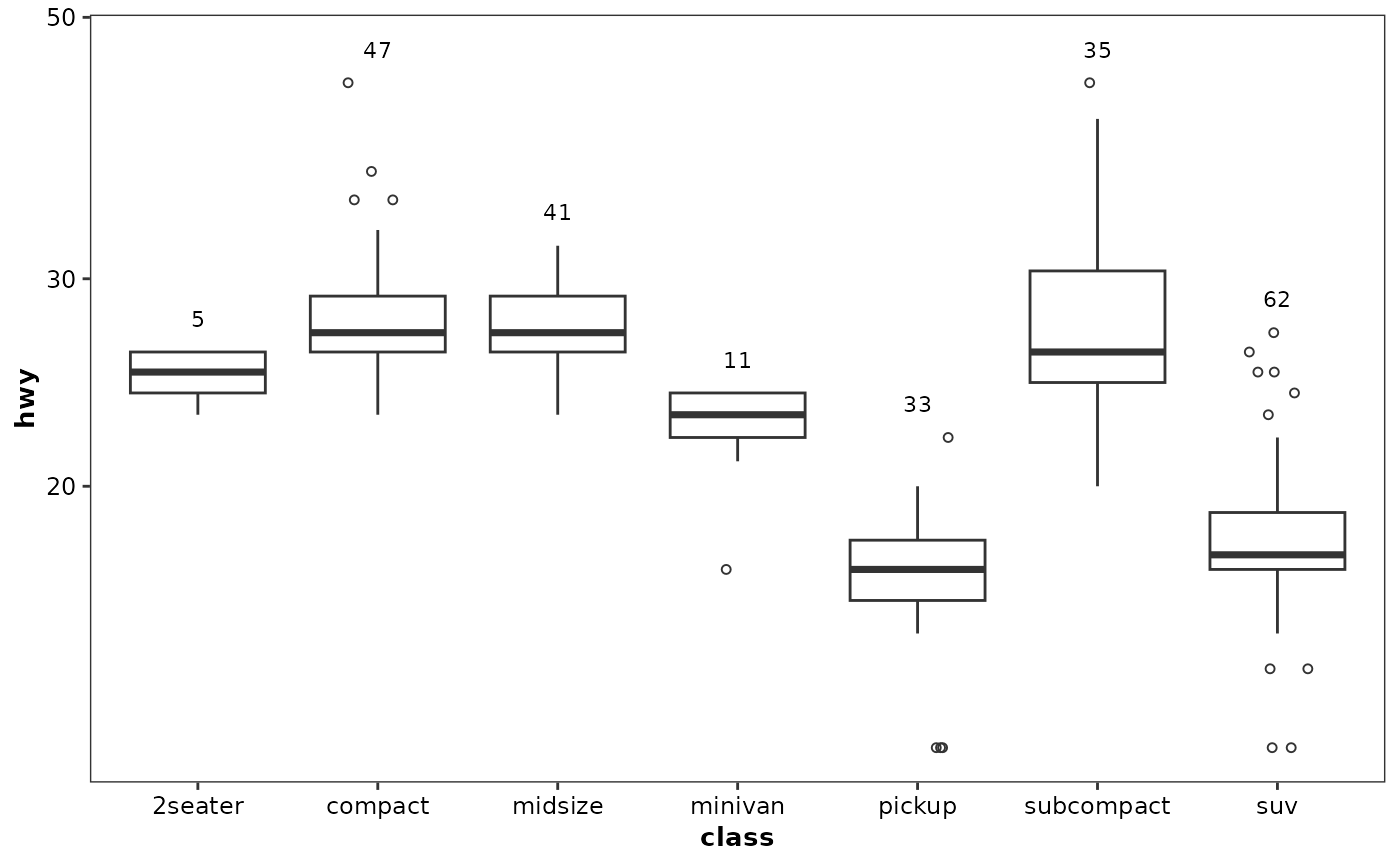This function is intended to work in combination with
geom_boxplot2 to display the number of data points used for the
calculation of statistics which are graphically represented by each box and
whiskers.
geom_boxcount(
mapping = NULL,
data = NULL,
stat = "boxcount",
position = "dodge2",
...,
spacing = 0.05,
outlier.position = "jitter",
na.rm = FALSE,
orientation = NA,
show.legend = FALSE,
inherit.aes = TRUE
)
stat_boxcount(
mapping = NULL,
data = NULL,
geom = "boxcount",
position = "dodge2",
...,
coef = 1.5,
spacing = 0.05,
na.rm = FALSE,
orientation = NA,
show.legend = FALSE,
inherit.aes = TRUE
)Arguments
- mapping
Set of aesthetic mappings created by
aes(). If specified andinherit.aes = TRUE(the default), it is combined with the default mapping at the top level of the plot. You must supplymappingif there is no plot mapping.- data
The data to be displayed in this layer. There are three options:
If
NULL, the default, the data is inherited from the plot data as specified in the call toggplot().A
data.frame, or other object, will override the plot data. All objects will be fortified to produce a data frame. Seefortify()for which variables will be created.A
functionwill be called with a single argument, the plot data. The return value must be adata.frame, and will be used as the layer data. Afunctioncan be created from aformula(e.g.~ head(.x, 10)).- position
Position adjustment, either as a string naming the adjustment (e.g.
"jitter"to useposition_jitter), or the result of a call to a position adjustment function. Use the latter if you need to change the settings of the adjustment.- ...
Other arguments passed on to
layer(). These are often aesthetics, used to set an aesthetic to a fixed value, likecolour = "red"orsize = 3. They may also be parameters to the paired geom/stat.- spacing
Fraction of the panel range used as the margin between the boxplot and the count. If spacing is positive, counts are displayed using a margin that is relative to the maximum value of each boxplot. If spacing is negative, counts are displayed using a margin that is relative to the minimum value of each boxplot. If spacing is Inf, all counts are displayed at the top of the data range. If spacing if -Inf, all counts are displayed at the bottom of the data range. Defaults to 0.05.
- outlier.position
This controls the placement of the counts above the boxes, depending on whether outliers were hidden (
outlier.position = NULL) or displayed (outlier.position = 'identity'oroutlier.position = 'jitter') when the call togeom_boxplot2was made. By default, outliers are assumed to be displayed.- na.rm
If
FALSE, the default, missing values are removed with a warning. IfTRUE, missing values are silently removed.- orientation
The orientation of the layer. The default (
NA) automatically determines the orientation from the aesthetic mapping. In the rare event that this fails it can be given explicitly by settingorientationto either"x"or"y". See the Orientation section for more detail.- show.legend
logical. Should this layer be included in the legends?
NA, the default, includes if any aesthetics are mapped.FALSEnever includes, andTRUEalways includes. It can also be a named logical vector to finely select the aesthetics to display.- inherit.aes
If
FALSE, overrides the default aesthetics, rather than combining with them. This is most useful for helper functions that define both data and aesthetics and shouldn't inherit behaviour from the default plot specification, e.g.borders().- geom, stat
Use to override the default connection between
geom_boxcountandstat_boxcount.- coef
Length of the whiskers as multiple of IQR (if lower than 50) or a confidence interval (if greater than or equal to 50). Defaults to 1.5.
Orientation
This geom treats each axis differently and, thus, can thus have two orientations. Often the orientation is easy to deduce from a combination of the given mappings and the types of positional scales in use. Thus, ggplot2 will by default try to guess which orientation the layer should have. Under rare circumstances, the orientation is ambiguous and guessing may fail. In that case the orientation can be specified directly using the orientation parameter, which can be either "x" or "y". The value gives the axis that the geom should run along, "x" being the default orientation you would expect for the geom.
Aesthetics
geom_boxcount() understands the following aesthetics (required aesthetics are in bold):
xoryalphaanglecolourfamilyfontfacegrouphjustlineheightsizevjust
Learn more about setting these aesthetics in vignette("ggplot2-specs").
See also
Examples
library(ggplot2)
p <- ggplot(mpg, aes(class, hwy))
p +
geom_boxplot2() +
geom_boxcount()
#> Warning: Width not defined. Set with `position_dodge2(width = ...)`
 # For display on log axis scale, use the scale_y_continuous function
# Using coord_trans(y ='log10') would display the counts at the wrong place
p +
geom_boxplot2() +
geom_boxcount() +
scale_y_continuous(trans = 'log10')
#> Warning: Width not defined. Set with `position_dodge2(width = ...)`
# For display on log axis scale, use the scale_y_continuous function
# Using coord_trans(y ='log10') would display the counts at the wrong place
p +
geom_boxplot2() +
geom_boxcount() +
scale_y_continuous(trans = 'log10')
#> Warning: Width not defined. Set with `position_dodge2(width = ...)`
